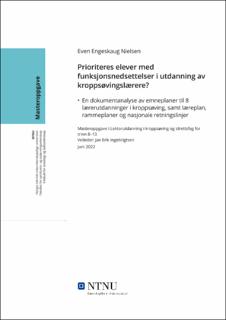| dc.contributor.advisor | Ingebrigtsen, Jan Erik | |
| dc.contributor.author | Nielsen, Even Engeskaug | |
| dc.date.accessioned | 2022-07-20T17:20:28Z | |
| dc.date.available | 2022-07-20T17:20:28Z | |
| dc.date.issued | 2022 | |
| dc.identifier | no.ntnu:inspera:104662048:9965348 | |
| dc.identifier.uri | https://hdl.handle.net/11250/3007387 | |
| dc.description.abstract | Hensikten med denne studien har vært å undersøke lærerutdanninger i kroppsøving og deres dekning av elever med funksjonsnedsettelser som tematikk i emneplaner. Mange elever med særskilte behov opplever ekskludering og et dårligere psykososialt skolemiljø enn andre elever (Nordahl et al., 2018). Inkludering i kroppsøvingstimen kan derfor være viktig for å fremme elevenes fysisk-motoriske og sosiale utvikling (Bailey, 2005; Ommundsen, 2013). Dermed er det betydningsfullt at kroppsøvingslæreren har kompetanse til å inkludere elevene.
Læreplanen som styringsdokument setter rammer for hele utdanningssystemets virksomhet (Aasen et al., 2014), noe som blant annet har implikasjoner for Forskrift om rammeplan og Nasjonale retningslinjer for lærerutdanningene. På bakgrunn av dette ble det satt søkelys på mulige maktaspekter gjennom plandokumentenes funksjoner og virkeområder. Dermed ble læreplan, rammeplaner og nasjonale retningslinjer inkludert i forskningsarbeidet, som ledet til problemstillingen:
Kan systemmakt og institusjonelle faktorer bidra til å forklare i hvilken grad elever med funksjonsnedsettelser prioriteres i utdanningen av kroppsøvingslærere, og er i tråd med lærerplanene for skolen?
Utdanningsinstitusjonens autonomi ble også tematisert. Kvalitativ dokumentanalyse ble brukt som metode i den empiriske gjennomgangen og analysen av plandokumentenes innhold. Utenom få unntak, viser studien at lærerutdanningene i liten grad prioriterer elever med funksjonsnedsettelser i sine emnebeskrivelser. Dette samsvarer med grad av dekning i læreplan, rammeplaner og retningslinjer, noe som fremhever utdanningssystemets systemmakt som en mulig forklaringsmodell for tematikkens mangelfulle vektlegging. | |
| dc.description.abstract | The purpose of this study has been to examine physical education teacher programs and their coverage of disabilities as a topic in their syllabi. Many students with special needs encounter exclusion and a more negative psychosocial school environment (Nordahl et al., 2018). Thus, inclusion in physical education can be an important factor to enhance the students' physical-motor and social development (Bailey, 2005; Ommundsen, 2013). Consequently, the physical education teachers’ disability competence cannot be underestimated.
The curriculum as a managing document sets the frame for the entire education system's activities (Aasen et al., 2014), which has implications on the framework plan and national guidelines for teacher education. Based on this, the spotlight was put on possible aspects of power through functions and areas of activity of the documents. The curriculum, framework plans and national guidelines documents were therefore included in the research, which led to the thesis statement:
“Can systemic power and institutional factors help to explain the extent to which students with disabilities are given priority in the education of physical education teachers, and are in line with the schools’ curricula?”
The educational institution's autonomy was also themed. Qualitative document analysis was used as a method in the empirical review and analysis of the content of the different documents. With few exceptions, the study shows that physical teacher educations to a small extent gives priority to students with disabilities in their course descriptions. This corresponds with the small amount of coverage in the curriculum, framework plans and national guidelines, which underlines systemic power in the educational system as a possible explanatory model for the theme's lack of emphasis on several planning levels. | |
| dc.language | nob | |
| dc.publisher | NTNU | |
| dc.title | Prioriteres elever med
funksjonsnedsettelser i utdanning av
kroppsøvingslærere? | |
| dc.type | Master thesis | |
